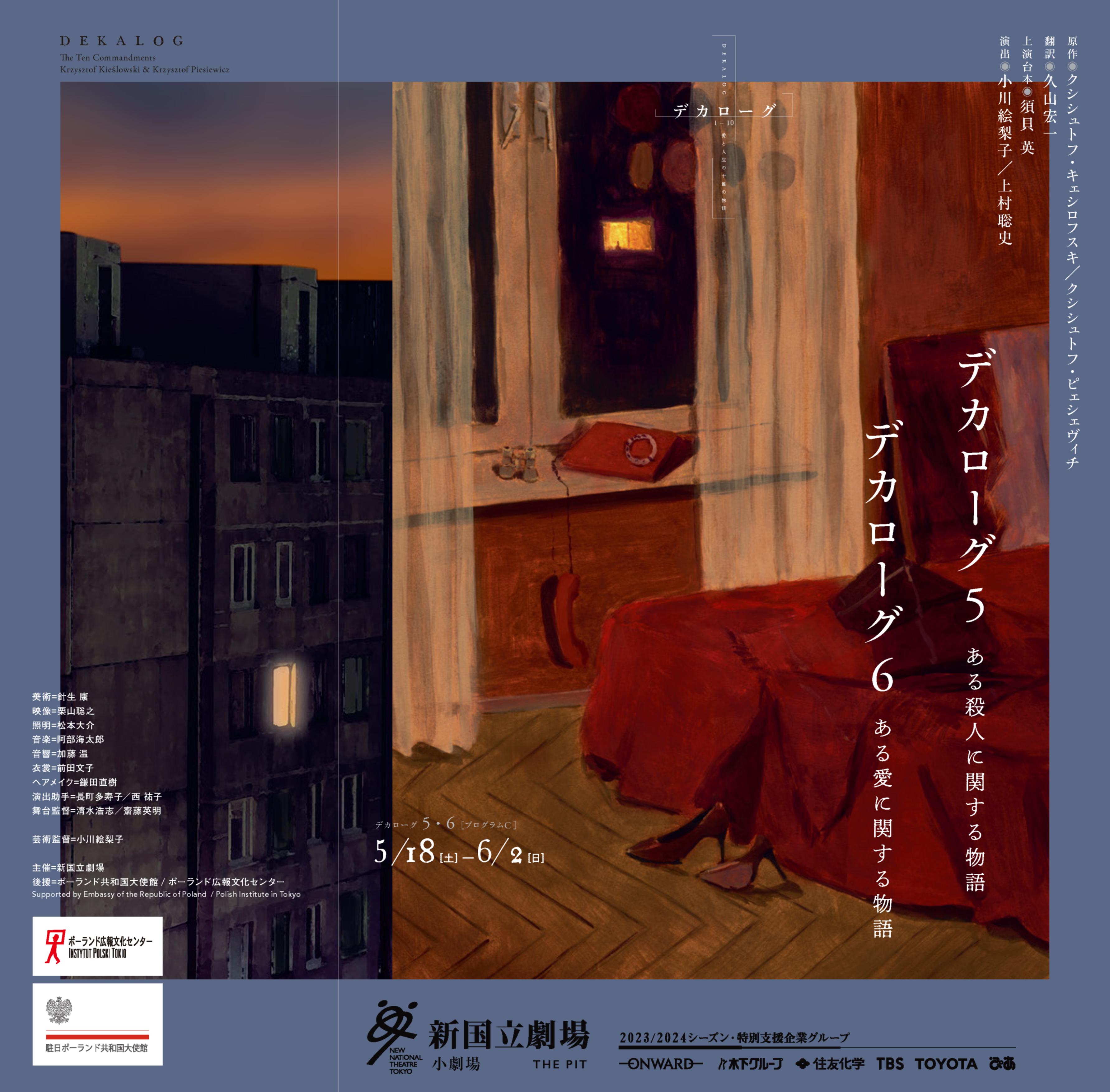
SH
7 Jul 2024
デカローグ 舞台装置 レビュー
文=荻野 洋一 制作=キネマ旬報社
"ところが今回の新国立劇場のステージでは、アパートメントの構造がコーナーキューブ状に組まれて、空間そのものが骨組み化され、抽象性と可塑性が強調されている。キューブの中身はスプレッドシートのセルを書き換えるかのごとく、エピソードごとに自在に装飾替えがほどこされ、かえってその自在さが、現代生活の可逆性、没個性性、不安定性を炙り出している。ヨーロッパの演劇シーンでも高い評価を得てきた舞台美術家・針生康(はりう・しずか)によるセット構造そのものが、本作の真の主人公ではないか。演者たちはこのコーナーキューブ状の美術セットを上下左右に動き回るが、動き回れば回るほど、人間存在の卑小さを痛感させるしくみになっている。事の本質を醒めた眼で透過した、じつにおそるべき美術セットである。"
Yoichi Ogino Production by Kinema Junpo (Cinema Magazine)
"On the stage of the New National Theatre, however, the structure of the flat is assembled in the form of a corner cube, and the space itself is skeletonised, emphasising abstraction and plasticity. The contents of the cube are freely rearranged for each episode, as if the cells of a spreadsheet were being rewritten, and this flexibility reveals the reversibility, impersonality and instability of contemporary life. The set structure itself, created by stage designer Shizuka Hariu, who is also highly regarded in the European theatre scene, is the true protagonist of this work. The performers move up, down, left and right around this corner cube-shaped art set, but the more they move around, the more painfully they realise how small human existence is. It is a truly terrifying art set that penetrates the essence of the matter with an enlightened eye."
港 岳彦 (脚本家/九州大学芸術工学研究院教授)
”今、あの10篇の物語が、洗練を極めるミニマムな舞台芸術にみごと転生したことに感動している。原作が駆使した暗喩や象徴を明瞭に絵解きして再構築した舞台装置の妙。原作が海外の作品であることを忘れさせる演者たちの真実味。この物語群は劇場から世界へと、確かに広がっている。”
Takehiko Minato、Professor and Dramatist
"Now I am impressed by the ten stories that have been beautifully reincarnated into minimalist theatre art of the utmost sophistication. The stage set-up is a marvellous reworking of the metaphors and symbolism of the original stories, clearly illustrated. The veracity of the performers makes us forget that the original is a foreign work. This group of stories has indeed spread from the theatre to the world."
文=荻野 洋一 制作=キネマ旬報社
"筆者は「デカローグ」1〜4話について書いたレビュー記事、および5&6話についてのレビュー記事において、この未曾有の大型演劇プロジェクトの真の主人公は、人間たちのうごめく数棟の集合住宅である、と重ねて強調してきた。そしてそのうごめきを根底から支えるコーナーキューブ状の空間をしつらえた針生康(はりう・しずか)によるセット構造こそ、今回の連続上演の肝であり、ヨーロッパ演劇シーンでも高い評価を得てきたこの舞台美術家がエピソードごとに縦横無尽に組み替えてみせるセット構造が、人間生活の代替性、可塑性、非人称性、没個性を残酷にきわだたせているのだと強調してきた。........
デカローグ1〜4について書いた前回原稿で筆者は、「デカローグ」舞台上演版の真の主人公は、団地の建物そのものだと述べた。ヨーロッパ演劇シーンで高い評価を得てきた舞台美術家・針生康(はりう・しずか)によるコーナーキューブ状の美術セットが、社会主義末期の庶民の暮らしを、抽象的かつ可塑的に炙り出していた。しかしデカローグ5『ある殺人に関する物語』では団地のプレゼンスは後景に退いて、その軒先スペースが無造作に映画館の窓口となり、殺人現場となり、裁判所となり、処刑場となっていく。住居としての機能が剥奪され、人間ばかりでなく、場所もさしたるセットチェンジさえないままに代替性、相互置換性、可塑性が強調されている。一方、デカローグ6『ある愛に関する物語』ではコーナーキューブ状の美術セットが再び住居としての機能を回復し、隣接した棟の窓と窓という劇的な視線劇を現出せしめる。"
Yoichi Ogino Production by Kinema Junpo (Cinema Magazine)
"In the previous article written about Decalogue 1-4, the author stated that the real protagonist of the stage performance version of Decalogue is the apartment block building itself. The corner cube-shaped art set by stage designer Shizuka Hariu, who has been highly acclaimed in the European theatre scene, seared the lives of ordinary people at the end of the socialist era in an abstract and plastic manner. In Decalogue 5: A Story of a Murder, however, the presence of the apartment block recedes into the background and its eaves space becomes a haphazard cinema window, a murder scene, a courtroom and an execution site. Stripped of its function as a dwelling, not only the people but also the place emphasises substitutability, inter-substitutability and plasticity without even the slightest set change. On the other hand, in Decalogue 6, A Story about Love, the corner-cube art set regains its function as a dwelling, revealing a dramatic eye drama of windows to windows in adjacent wings."
文=荻野 洋一 制作=キネマ旬報社
”筆者は「デカローグ」1〜4話について書いたレビュー記事、および5&6話についてのレビュー記事において、この未曾有の大型演劇プロジェクトの真の主人公は、人間たちのうごめく数棟の集合住宅である、と重ねて強調してきた。そしてそのうごめきを根底から支えるコーナーキューブ状の空間をしつらえた針生康(はりう・しずか)によるセット構造こそ、今回の連続上演の肝であり、ヨーロッパ演劇シーンでも高い評価を得てきたこの舞台美術家がエピソードごとに縦横無尽に組み替えてみせるセット構造が、人間生活の代替性、可塑性、非人称性、没個性を残酷にきわだたせているのだと強調してきた。......
今回の壮大プロジェクト「デカローグ」で起きたこととは、不可能であるはずのショット/リバースショット(切り返しショット)を仮構しつつ、舞台を見ているはずの私たち観客を登場人物が見返すことであり、私たち観客は、この巨大作品の主人公たる集合住宅の建築物そのものへと転化させられる形となったのである。このような異様な試みによって、私たちは、知らず知らずのうちに作品内へと吸収されていたわけである。物語環境への観客の吸収というこの事態に、私たちは大いに戦慄すべきである。”
Yoichi Ogino Production by Kinema Junpo (Cinema Magazine)
"In the review articles I wrote on Decalogue episodes 1-4 and 5 & 6, I repeatedly stressed that the real protagonists of this unprecedented large-scale theatre project are a series of houses in which people are seething. The set structure by Shizuka Hariu, who has created a corner cube-like space that underpins these groans, is the heart of this series of performances, and the set structure, which the stage designer, who is also highly regarded in the European theatre scene, reconfigures in all directions from episode to episode, is the key to the human The set structure, which the set designer, who is highly regarded on the European theatre scene, reconfigures in every episode, brutally highlights the substitutability, plasticity, impersonality and impersonal nature of human life.....
What happened in the spectacular project "Decalogue" was that the characters looked back at us, the audience, who were supposed to be watching the stage, while they were temporarily constructing a shot/reverse shot (a turnaround shot), which should have been impossible, and we, the audience, were transformed into the very architecture of the housing complex that was the protagonist of this huge work. We, the spectators, were transformed into the main character of this gigantic work, the building of the housing complex itself. In this bizarre experiment, we were unwittingly absorbed into the work. This absorption of the spectator into the narrative environment should make us shudder.



